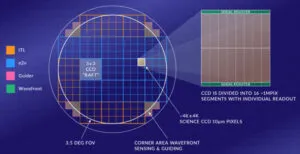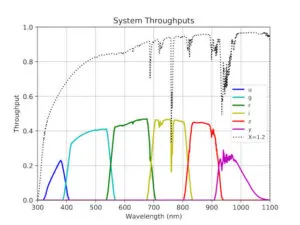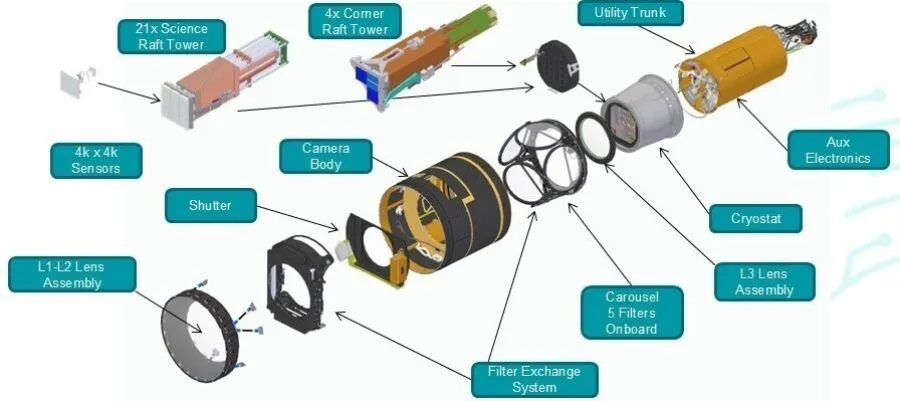Assembled by Stanford University’s SLAC laboratory in California, the camera assembly that picks up light from the triple mirror telescope is 4.5m long, 1.65m in diameter and weights three tonnes.
Its 640mm sensitive circle gives the camera a ±1.75° field of view, which the observatory points out can fit 7 full moons along a diameter.
All told there are 3.2Gpixel, with each pixel covering 0.2arcsecond of sky.
 The image sensor is spread across 189 CCD die in the form of 21 modules – called ’tiles’ – each with 3 x 3 CCDs on the front, backed by electronics, and cooling to achieve the -100°C operating temperature.
The image sensor is spread across 189 CCD die in the form of 21 modules – called ’tiles’ – each with 3 x 3 CCDs on the front, backed by electronics, and cooling to achieve the -100°C operating temperature.
Two organisations are making almost identical CCDs for the sensor, roughly half each: Teledyne E2V in Essex UK, and the University of Arizona’s Imaging Technology Laboratory.
Each CCD has a 4k x 4k array (16Mpixel) of 10µm pixels on a 100µm substrate flattened to within 5μm. Silicon carbide is used in the construction for its physical rigidity and stability.
The image processing pipeline includes a stage to remove pixel-to-pixel sensitivity variations.
It takes two seconds to read the data from each CCD though its 16 outputs, each handling a million pixels. Noise, according to Teledyne, is five electrons.
For maximum coverage, the CCD die are designed to butt edge to edge on all four sides.
Gaps are around a quarter of a millimetre between die on the same 3 x 3 module, and half a millimeter between modules.
Sensitivity spans 320 – 1,050nm, which is near-UV to infra-red.
 This is divided into six bands by external filters, five of which can be stored within the camera on any particular night.
This is divided into six bands by external filters, five of which can be stored within the camera on any particular night.
The five-lens carousel mechanism is ingenious as it hugs un-used filters close around the light path to keep the camera narrow, and yet can automatically swap filters in two minutes – the externally-stored lens has to be swapped manually, something that is expected once every few weeks.
The camera also holds the three lenses that follow the three mirrors in the light path.
Each active night, around a thousand 30s exposures will produce 20Tbyte of data, adding up to 60Pbyte over the planned 10 year observing programme.
Optical fibres take this data into Chile’s network, where it moves onto the international fibre network, and eventually to SLAC in Stanford.
At SLAC, it will be initially processed to identify potentially interesting changes, which will automatically trigger alerts – 10 million alerts a night are expected. “The entire process, from image to data transfer to alert, happens in less than 60 seconds,” according to the Observatory.
This telescope is unusual in that researchers cannot book time on it. Instead a fixed 10 year program of methodical observations, covering the sky once every three days, and researches will apply for access to the data – which is available sorted and processed in various ways.
The camera is just one novel aspect of this observatory – the 8.4m combined primary and tertiary lens, which took seven years to make, and the ultra-rigid support structure that re-positions the telescope in five seconds, are also worth a look.
Naming of the parts:
The complete observatory is known by the full name: NSF-DOE Vera C Rubin Observatory.
Inside that is the ‘Simonyi Survey Telescope’, part of which is the ‘Legacy Survey of Space and Time Camera’ (LSST Camera).
Scroll down this Ruben Observatory page to find more technical details of CCD performance.
Funded for the observatory came from the US National Science Foundation and the Department of Energy’s Office of Science.
Image credits: Vera Rubin Observatory, SLAC
